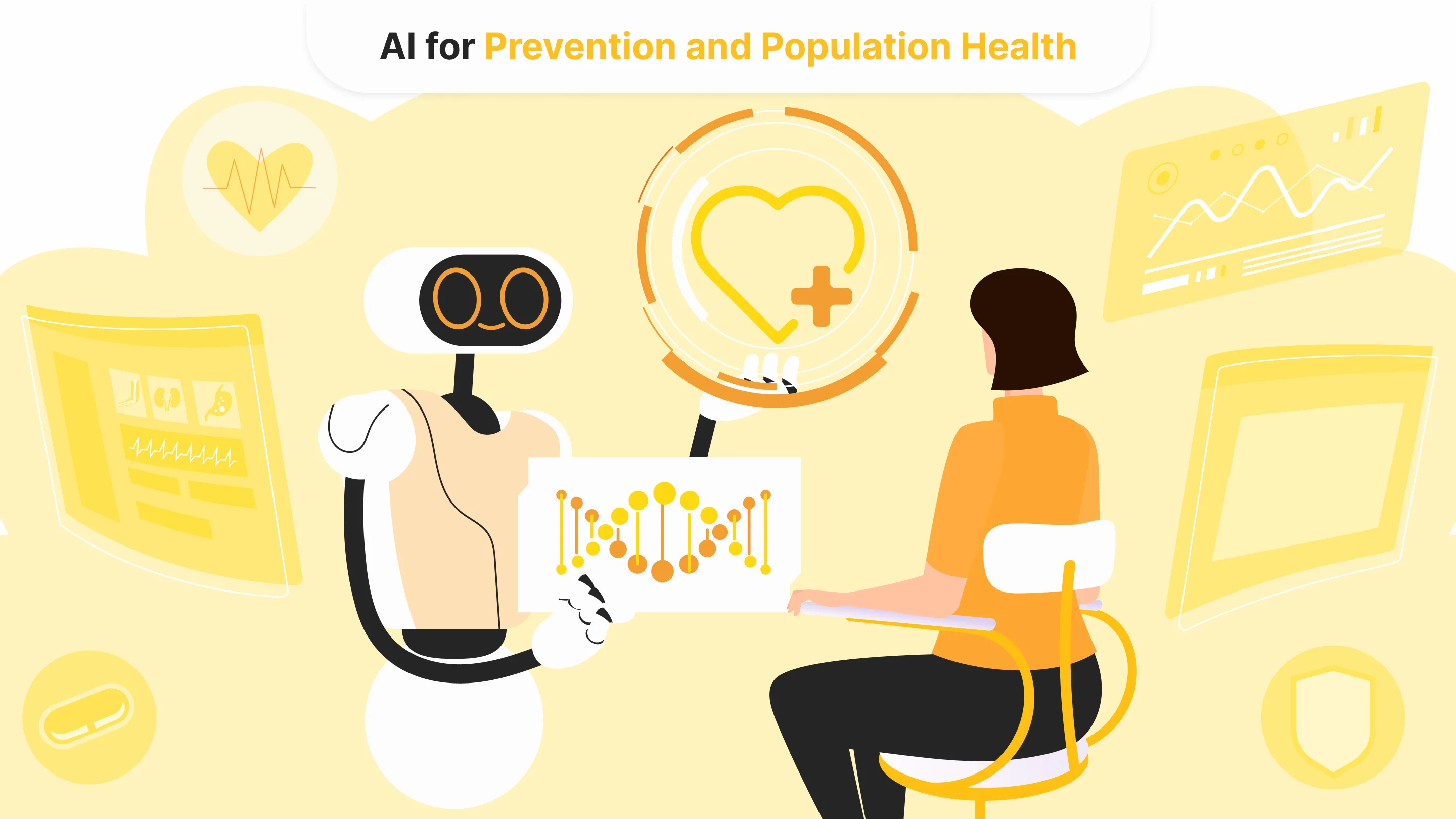

The Role of AI in Tackling Non-Communicable Diseases Globally
In the 21st century, it’s not infectious outbreaks that claim the most lives — it’s the slow, persistent march of non-communicable diseases (NCDs). Heart attacks, strokes, diabetes, cancers, and chronic respiratory diseases — together, they account for over 70% of all deaths worldwide. And what’s even more staggering is that many of these deaths are preventable.
Non-communicable diseases are often labeled as “lifestyle-related,” but that framing masks a deeper, more complex reality. Genetics, environmental factors, social determinants, limited access to care, it’s a tangle of causes that traditional healthcare systems have struggled to manage effectively, especially when it comes to early detection and long-term management.
Now, artificial intelligence is entering the picture. And unlike many buzzword-filled tech trends, this one might actually deliver. AI is uniquely suited to tackle the scale, complexity, and chronic nature of NCDs. It doesn’t get tired. It sees patterns across millions of patients. It can flag subtle changes that no human eye could catch, and it can do all of this in real time.
But this isn’t a utopian vision of robots replacing doctors. In fact, the most promising use cases are the ones where AI works quietly in the background, boosting clinical decisions, triaging cases, identifying risks, and nudging people toward healthier behaviors. From a smartphone app that spots arrhythmias before they become life-threatening, to algorithms that personalize cancer treatments based on thousands of genetic markers, AI is already changing how we understand and treat chronic diseases.
This article takes a deep dive into the real-world applications of AI in fighting NCDs. We’ll explore success stories, cautionary tales, and lessons from across the globe. And we’ll ask the most important question of all: what will it take to make these innovations available to everyone, not just the privileged few?
Why AI is a Game-Changer for NCDs
Artificial intelligence is not a magic bullet, but when it comes to non-communicable diseases, it might be the most powerful tool we’ve ever had. The reasons are both simple and profound: NCDs are data-heavy, time-sensitive, and deeply individual. AI thrives under those exact conditions.
Let’s start with the data. NCDs don’t appear overnight. They unfold over years, sometimes decades — visible in slight fluctuations in blood pressure, subtle changes on a retinal scan, or patterns in daily behavior. Most healthcare systems aren’t equipped to connect these dots across time. Doctors are busy. Records are fragmented. And subtle warning signs often go unnoticed until it’s too late.
AI changes that. By aggregating and analyzing vast amounts of data, from electronic health records (EHRs), wearable devices, lab reports, imaging, genomics, and even social media, AI can spot patterns and risks no human could detect. For instance, a model trained on thousands of ECG readings can learn to predict heart failure months before symptoms appear, for example, a capability that’s already being deployed by the Mayo Clinic with its AI-enabled ECG algorithms.
Speed matters, too. A radiologist might review 20 CT scans a day. An AI model can process hundreds in minutes, flagging suspicious lesions or early-stage tumors for closer review. Studies have shown that AI can match or even exceed the accuracy of human experts in tasks like breast cancer detection on mammograms.
But it’s not just about more data or faster processing. The real strength of AI lies in personalization. Two people with the same diagnosis might respond very differently to the same treatment. AI models can account for these nuances, analyzing comorbidities, medications, genetic variations, and lifestyle factors to suggest individualized care plans. Tempus, for example, uses AI to tailor cancer treatment recommendations based on genomic and clinical data, helping oncologists make more informed decisions.
And then there’s accessibility. In regions where there aren’t enough doctors, or any specialists at all, AI can extend care beyond hospitals and clinics. Tools like portable AI-powered ultrasound, smartphone-based retinal screening, or AI-assisted diagnostic apps allow frontline health workers to do more with less. In India, low-cost fundus cameras paired with offline AI algorithms have demonstrated feasibility and accuracy for diabetic retinopathy screening in rural populations, requiring as little as 1–2 days of hands‑on training for local health workers.
It’s not perfect, of course. Algorithms are only as good as the data they’re trained on. Bias, blind spots, and overfitting are real risks — ones we’ll explore later in this article. But the potential is undeniable. Where traditional medicine often reacts to disease, AI can predict, prevent, and personalize, and that’s a game-changer for the slow-burning crisis of NCDs.
Case Studies: How AI Tackles NCDs in the Real World
Artificial intelligence is no longer confined to labs or pilot projects — it's actively reshaping how we detect, diagnose, and manage non-communicable diseases across diverse settings.
One of its most valuable roles is in early detection, especially for conditions that remain silent for years. At the Mayo Clinic, for example, researchers developed an AI algorithm that analyzes standard 12-lead electrocardiograms to detect low ejection fraction — an early indicator of asymptomatic heart failure. In a large-scale clinical trial (EAGLE), involving over 22,000 patients, the algorithm helped identify 32% more cases of reduced heart function compared to standard care, allowing for earlier intervention and potentially life-saving treatments.
In rural India, AI is transforming diabetic eye care. Community health workers, equipped with portable fundus cameras attached to smartphones, can now screen patients for diabetic retinopathy with the help of offline AI algorithms. In one pilot study, the combination of the Remidio Fundus on Phone (FOP) device and EyeArt software achieved high sensitivity and specificity in detecting referable cases, performing comparably to trained ophthalmologists. Broader reviews have confirmed this approach can scale effectively in low-resource settings, with sensitivities exceeding 90%.
AI is also making strides in respiratory health. A notable example is ResAppDx, an AI model that diagnoses respiratory conditions such as asthma and pneumonia using cough sounds recorded via smartphone. In a multicenter study involving over 500 children, the system achieved a positive agreement for asthma and for pneumonia compared to clinical diagnoses, highlighting the potential of contactless, scalable diagnostics.
What these examples share is not just technological innovation, but clinical relevance. They work in clinics, villages, and households, often with minimal infrastructure. The result is earlier detection, broader reach, and more equitable care. AI isn’t replacing clinicians; it’s helping them reach further and see more, often in places where health systems struggle to keep up.
AI for Prevention and Population Health

The true promise of AI in healthcare isn’t just in reacting faster, it’s in preventing illness before it takes hold. When applied at the population level, artificial intelligence becomes a lens through which health systems can see risk patterns, anticipate crises, and intervene early. This is especially vital in the battle against non-communicable diseases, where prevention is often more effective and far more affordable than late-stage treatment.
One major area of impact is predictive analytics. By aggregating data from medical records, wearable devices, lab tests, and even geospatial and environmental inputs, AI models can identify who is most likely to develop hypertension, diabetes, or cardiovascular disease, sometimes years before a formal diagnosis. In the UK, researchers have shown that patterns in accelerometer data, recorded by wrist-worn activity trackers, can differentiate individuals with type 2 diabetes from normoglycemic participants, using only a week’s worth of free-living activity data.
This kind of foresight is especially powerful in low-resource settings. In Kenya, AI-driven mobile tools are used to detect clusters of NCD-related symptoms and guide outreach campaigns before formal outbreaks are recorded. And in Brazil, researchers have used AI models to forecast hospital demand related to chronic diseases across urban neighborhoods, allowing cities to pre-position mobile clinics and expand telemedicine coverage.
At the individual level, AI is also fueling behavior change. Smart assistants, chatbot counselors, and mobile nudging apps are helping people adopt healthier lifestyles — whether it's quitting smoking, managing stress, improving diet, or increasing activity.
The Road Ahead
For all the breakthroughs and buzz, AI in healthcare still lives mostly in pockets — pockets of funding, infrastructure, and vision. The challenge now is not inventing better algorithms. It's making the existing ones reach further, embed deeper, and work equitably across different populations and settings.
One of the key questions ahead is how we scale AI without scaling inequality. Today’s most advanced AI models are trained primarily on datasets from high-income countries, and often from well-insured, urban, and digitally literate patients. This leaves large parts of the world either invisible to the algorithms or exposed to bias. Bridging that gap will require more than importing Western tools into new environments. It demands localized data, culturally sensitive implementation, and frontline involvement at every step.
Another challenge is trust. Not just from regulators, but from patients and clinicians. If AI is to play a meaningful role in managing chronic illness, it must be explainable, transparent, and responsive to clinical realities, not a black box that occasionally spits out a risk score. Clinicians don’t need “AI that thinks.” They need AI that helps. That means interfaces that integrate smoothly into workflows, results that make sense, and models that can be questioned.
There’s also the question of integration. Many health systems are still struggling with the basics: digitizing records, standardizing data formats, and ensuring secure cloud access. Expecting them to leapfrog directly into AI-guided care isn’t realistic, unless we invest just as heavily in infrastructure and training as we do in innovation. Otherwise, we risk building intelligent tools for systems that aren’t ready to use them.
And finally, we need to shift our cultural mindset. AI is not here to automate compassion or replace human judgment. It’s here to extend our reach, reduce our blind spots, and surface insights we wouldn’t have seen on our own. That vision, of AI as a quiet partner in long-term care, is both more realistic and more powerful than any sci-fi alternative.
So, where are we headed? Toward a healthcare system that doesn’t just react to disease, but anticipates it. That doesn’t treat the average patient, but it understands the individual. That doesn’t overwhelm clinicians, but supports them. AI won’t cure NCDs on its own. But if we do this right, if we fix the foundations, close the gaps, and keep people at the center, it might just help us turn the tide.
Tell us about your project
Fill out the form or contact us

Tell us about your project
Thank you
Your submission is received and we will contact you soon
Follow us
